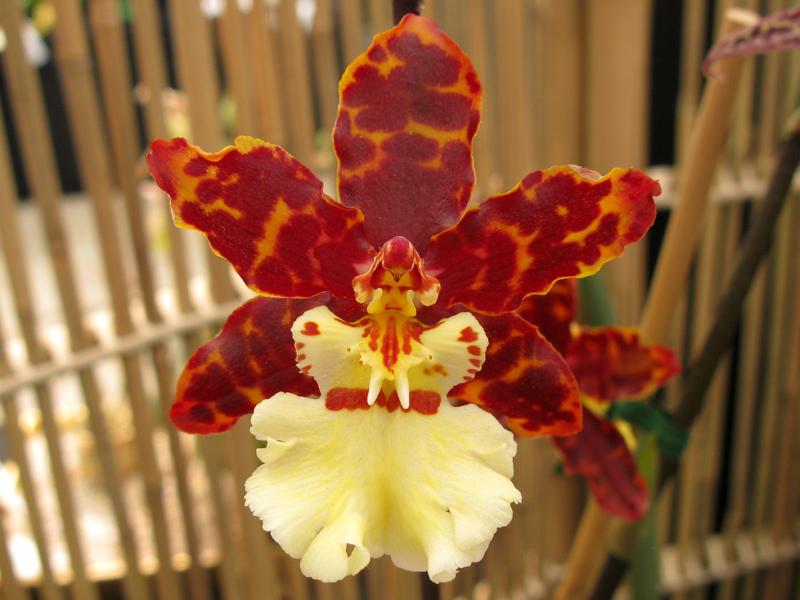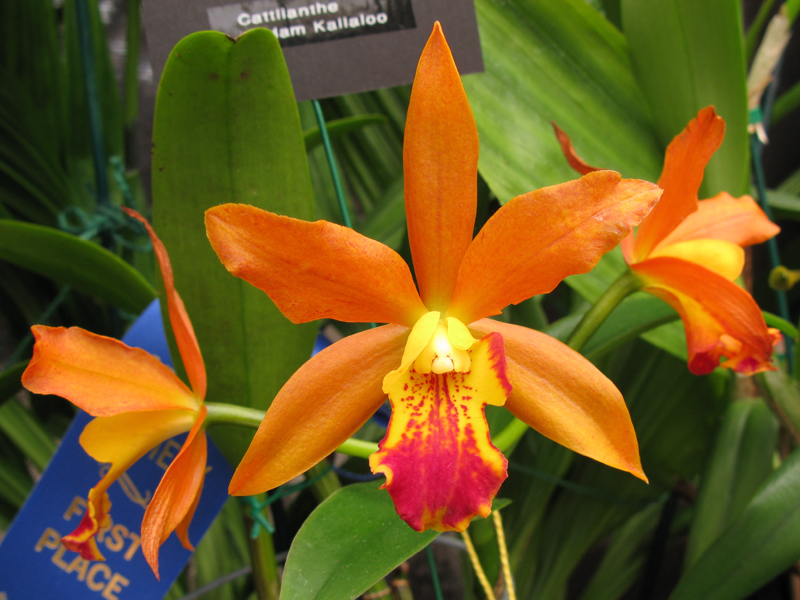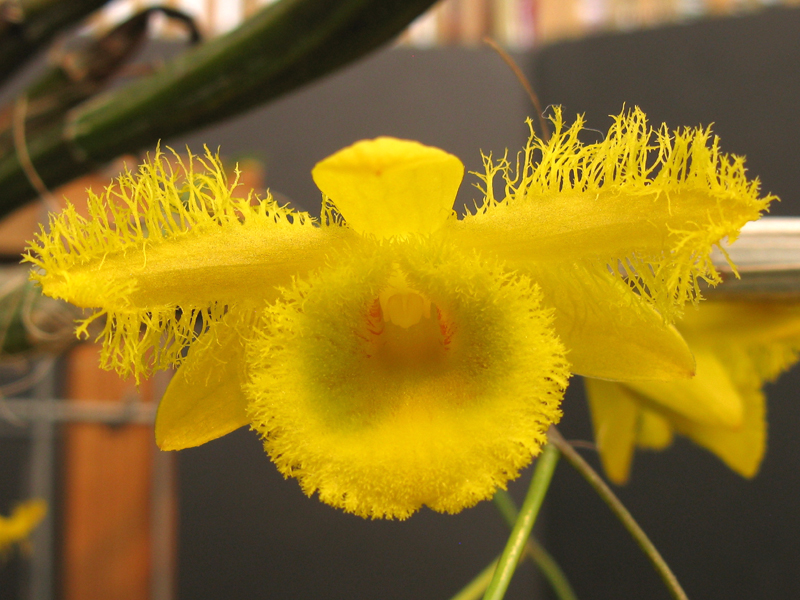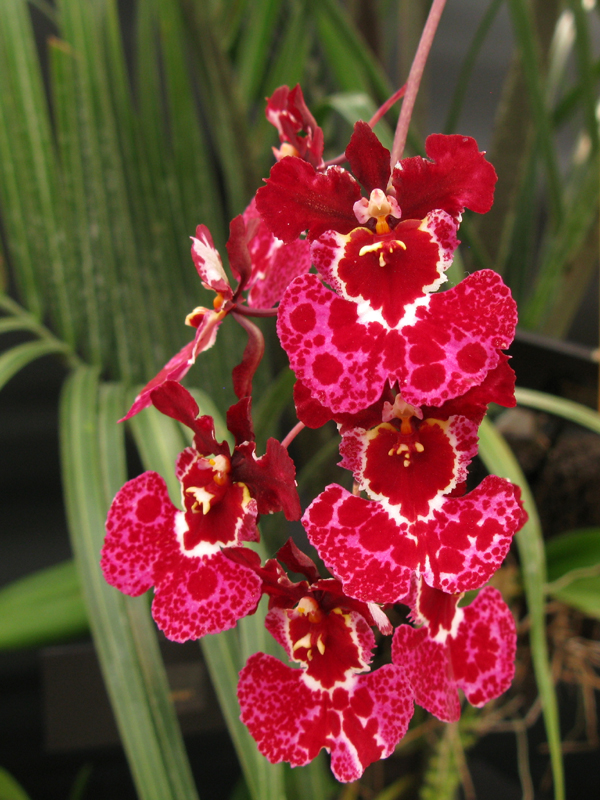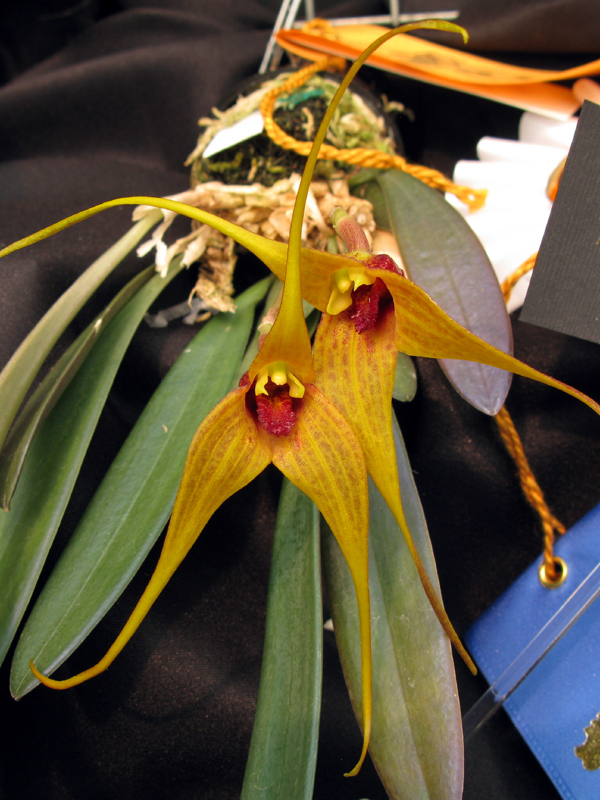9 March 2010
Orchids in the mist: the Denver orchid show
It never fails. The weather outside has to be absolutely horrid, otherwise it would be a break with tradition, it seems. On the day CJ and I drove to Tagawa Gardens for the 2010 Denver Orchid Society Spring Show, the interstate was shrouded in fog. The Rockies had completely disappeared, but we felt them as a solid presence somewhere beyond the grey banks to the west.
I'm always sort of disappointed when the displays incorporate intricate carnivorous plants and gorgeous bromeliads, because these plants have no place at an orchid show, however beautiful and interesting they may be. Worse is when they incorporate props, like fiber optic UFOs and (shudder) garden gnomes. Aren't orchids amazing enough? Just let them be, people. Thankfully, the Denver Orchid Society has too much good taste for that kind of thing. The well-constructed displays were fleshed out with lush, appropriate backdrop foliage; this fit the 'Orchid Oasis' theme for the show very well. Orchids from the genus Masdevallia and complex intergeneric hybrids from the Oncidiinae subtribe featured heavily in this season's show. For those of you who have absolutely no idea what the hell all that Latin means, here are some pictures of lovely orchids to enjoy!
Large, round, flat and near-ubiquitous, those pink and white hybrid moth orchids can be found in the house plant section of almost any grocery store these days. Coming face-to-face with their wild relatives is therefore always exciting, especially when they look entirely different. Feast your eyes on a lime-flowered version of Phalaenopsis cornu-cervi (above). The species name of this Southeast Asian moth orchid means deer-antlered, and it has curiously flattened inflorescences. With care, it can flower several times a year, unlike the store-bought hybrids, which generally flower only once a year. I also appreciate the fact that it has a starry shape, and not the flat, rounded shape we've come to expect from Phalaenopsis orchids.
This adorable Dendrobium from Thailand bears minute flowers on leafless pseudobulbs that resemble a stack of green grapes. I think this would be a gorgeous addition to a cool little terrarium. The genus Dendrobium with its infinite variety: it's easy to see why it's my favourite orchid genus.
When it comes to Masdevallia, virtually the whole genus is composed of miniature species. Masdevallia pteroglossa, from the cool cloud forests of Colombia, is a pixie among dwarves: the entire plant above would easily fit inside a coffee mug. The species name means wing-tongue, which refers to the dimunitive lip, which is only visible as a small red structure in the centre of the triangular flower.
This lovely specimen plant above was awarded a CCM (Certificate of Cultural Merit) by the American Orchid Society. This coveted award is only bestowed on exceptionally well-grown plants. It commends the patient and skilled grower able to bring out the full potential of an orchid. This Cochlioda, a member of the Oncidiinae subtribe, had a total of 16 inflorescences on it, bearing 102 buds and 320 open flowers! The judges described the hot pink petals as having the texture of "diamond dust". Cochlioda rosea is native to the rain forests of Peru and Ecuador, where it must be an awe-inspiring sight.
With more variations than you can shake a large stick at, the genus Dendrobium surprised us once again with the fuzzy-as-a-bumble-bee Dendrobium harveyanum. I loved the crystalline texture, the deeply fringed petals and the sweet scent. It appears dusted with pollen, but (as is typical for all orchids) the pollen is actually carried as sticky masses behind the anther cap, the small circular structure in the centre of the flower. This orchid is native to places in Southeast Asia with a monsoonal climate, and needs a dry winter rest in order for the flowers to develop in early spring.
The absolutely enormous orchid above was awarded Best Flower and Best Grown Plant. Dendrobium Spring Doll 'Sweetheart' is one of the so-called soft cane Dendrobium hybrids, and was originally bred by the Hawaiian firm H & R Nurseries. Soft canes have Dendrobium nobile and related species in their pedigree. Like Dendrobium harveyanum, soft canes need less water during their winter rest. This induces masses of flowers right before the growing season. I would recommend soft canes as good beginner's orchids, as they thrive on benign neglect.
Tolumnia is an interesting genus, also part of the Oncidiinae subtribe. They are found on the islands of the Caribbean, where they grow as twig epiphytes constantly soaked by rainstorms and dried by the tropical sun. This requirement for rapid wet-dry cycles tends to make them slightly tricky to grow well. However, this example of the hybrid Tolumnia Jairak Rainbow was a carnival of a plant: several inflorescences bearing gaudy coral pink blossoms stained with carmine, like a gaggle of calypso dancers ready for a street parade.
At every orchid show, there has to be one favourite. Dendrobium species tended to be the attention whores of orchid shows past. This time around, I became obsessed with a rather bizarre Masdevallia from southwestern Colombia: Masdevallia caesia. It has blue-grey leaves. It grows upside-down. It needs cool to cold growing conditions, like you'd find where the South American rain forests meet the Andes and the trees are constantly bathed in clouds. It has flowers that can be 23 cm long (and you thought all Masdevallia were small). The flowers have an unpleasant smell, and are pollinated by flies attracted to the furry red lip, which resembles decaying meat. It's exactly the sort of plant that sends those suffering from orchid fever into pure delirium.
23 December 2009
Author guidelines: what's past is prologue
 Last-minute Christmas shoppers are braving the snow and slush outside. I remain sequestered indoors, braving the labyrinthine folds of my own brain. I nurse mug after mug of rooibos, procrastinate by baking these, distract myself by reading that. I find myself at the interface between two parts of my research, you see, and it has taken the form of a mental chasm I am hesitant to traverse.
Last-minute Christmas shoppers are braving the snow and slush outside. I remain sequestered indoors, braving the labyrinthine folds of my own brain. I nurse mug after mug of rooibos, procrastinate by baking these, distract myself by reading that. I find myself at the interface between two parts of my research, you see, and it has taken the form of a mental chasm I am hesitant to traverse. In reality, I feel most fortunate to have made it this far. New insights into molecular biology are invariably gained using The Scientific Method, and my PhD research has been no exception. The first step is identifying a problem. In my field of study, the problem is that cereal plants manage to protect themselves against the ravages of insect pests, but we don't know how.* The next step is formulating a hypothesis that would address the problem, or some aspect of it. I therefore devised some gene-silencing experiments to test my hypothesis. I spent months in the lab, weeks in the greenhouse and tons of grant money. Most likely, I also inadvertently ate a couple of research subjects (aphids are small). I generated massive amounts of data, crunched the numbers, scrutinized the images, drew the graphs, did the statistics. I spent many hours in helpful discussion with my advisor. And now comes the next step in The Scientific Method: publishing the results.
 Ever since I was a child, I knew I wanted to help figure out how the world works. I wanted to add pieces to the puzzle, somehow contribute to our understanding of life itself. Today, I'm fulfilling that dream by investigating the wonderfully complex machinery inside cells that help genes to function. Being a geneticist, with a focus on cereal functional genomics, means the pieces I contribute to the puzzle of nature are rather specific. It all seems rather small. I tend to get caught up in the detail of it. The detail is fascinating, certainly, but sometimes it feels kind of trivial, or unimportant. But then I read Michael Pollan, or about Norman Borlaug and the Green Revolution, or about golden rice, or the looming Ug99 epidemic, and I realize that what I do has tremendous value to world food security. What I do will help feed the world.
Ever since I was a child, I knew I wanted to help figure out how the world works. I wanted to add pieces to the puzzle, somehow contribute to our understanding of life itself. Today, I'm fulfilling that dream by investigating the wonderfully complex machinery inside cells that help genes to function. Being a geneticist, with a focus on cereal functional genomics, means the pieces I contribute to the puzzle of nature are rather specific. It all seems rather small. I tend to get caught up in the detail of it. The detail is fascinating, certainly, but sometimes it feels kind of trivial, or unimportant. But then I read Michael Pollan, or about Norman Borlaug and the Green Revolution, or about golden rice, or the looming Ug99 epidemic, and I realize that what I do has tremendous value to world food security. What I do will help feed the world.  That's enough reason to get the word out and publish that paper. It is the final step to The Scientific Method. It also proves one of the most challenging. Which publication does one aim for? Should I be arrogant and aim for a high impact journal, with a very real chance of being rejected? Or do I aim for more a modest periodical and run the risk of my work falling into obscurity? Judging the worth of one's own research is really difficult, especially when you've been intimately involved with it for such a long period of time. The peer-review system ensures that only science of high quality gets published. It also means that the reviewers can be quite brutal, sometimes subjecting your raw data to a full-on audit, of sorts. So I need to be sure before I submit the manuscript. Was the experimental design inherently flawed? Did I include the appropriate controls during gene suppression? Did I transpose a decimal in a calculation somewhere? Are the levels of gene expression truly significantly different between treatments? Alone at night, huddled over my notebooks and spreadsheets, there are moments where I doubt myself. This I have no doubt about, though: with the right kind of angle, this thing will go to press. It deserves to. The story must be told. Without the smallest piece, no puzzle is complete.
That's enough reason to get the word out and publish that paper. It is the final step to The Scientific Method. It also proves one of the most challenging. Which publication does one aim for? Should I be arrogant and aim for a high impact journal, with a very real chance of being rejected? Or do I aim for more a modest periodical and run the risk of my work falling into obscurity? Judging the worth of one's own research is really difficult, especially when you've been intimately involved with it for such a long period of time. The peer-review system ensures that only science of high quality gets published. It also means that the reviewers can be quite brutal, sometimes subjecting your raw data to a full-on audit, of sorts. So I need to be sure before I submit the manuscript. Was the experimental design inherently flawed? Did I include the appropriate controls during gene suppression? Did I transpose a decimal in a calculation somewhere? Are the levels of gene expression truly significantly different between treatments? Alone at night, huddled over my notebooks and spreadsheets, there are moments where I doubt myself. This I have no doubt about, though: with the right kind of angle, this thing will go to press. It deserves to. The story must be told. Without the smallest piece, no puzzle is complete.And once all of it's over and done with, it's merely chapter one. Further hypotheses and fun in the lab to follow...
*More specifically, we know that so-called resistance genes allow plants to detect the presence of pests such as aphids, and act accordingly. Cereals like wheat can strengthen their cell walls, generate noxious chemicals like hydrogen peroxide - a sort of natural bug spray, if you will - and even kill off their own cells around aphid feeding sites, thereby depriving the bugs of their food supply. What we don't know is how plant defence mechanisms evolved. Nor do we know how they coordinate this massive reprogramming of their biochemistry. Some crop varieties are very good at it, while others do nothing to stop aphids from feeding on them and eventually just wither and die. We don't currently understand why this is the case.
16 October 2009
Pimp my petals: the Denver orchid show
There was snow along the highway as we headed for Echter's Garden Center in Arvada. The Denver Orchid Society Fall Show promised to inject some tropical colour into a rather dull October afternoon. The theme was 'Orchids of the World', and I was pleasantly surprised by the diverse amount of species on display. The usual suspects were of course chosen as class winners in their respective alliances: an electric blue Dendrobium victoria-reginae, a denizen of mossy oak forests in the Philippines;

a vibrant Ascocenda Su Fun Beauty, its petals the colour of overripe persimmons;

and Paphiopedilum Magic Lantern 'Memoria Elizabeth Sulzman', holding its pouch as if the plant itself had just blown it from pink bubblegum. Feed me, Seymour, indeed.

Many strange and unusual specimens were on show, to the delight of jaded orchid enthusiasts bored by saucer-sized vandas and over-hybridized cattleyas. This South American Zootrophion below is a prime example of the bizarre orchids on display. Its small cage-like flowers don't open fully, and are covered in tubercules. What sort of minute insect is brave enough to crawl inside these to pollinate them?

Cleisocentron merrillianum is an astonishing little beast from Borneo: its slate grey flowers had many visitors to the show fiddling with the macro settings on their cameras.

Easily overlooked, Eria coronaria had its flowers hidden away in lush green foliage. This fragrant species has a wide distribution and can be found from the Vietnamese coast all the way to the foothills of the Himalayas.
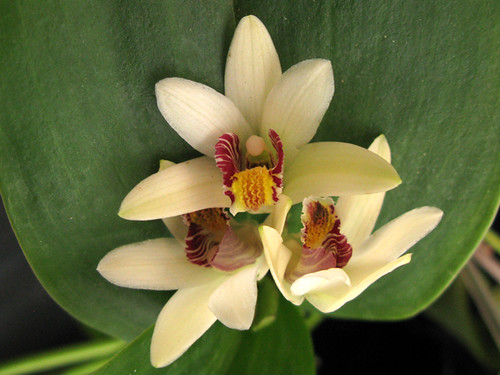
This sinuous monopodial with subtle chartreuse coloured blooms is called Christensonia vietnamica. It originates in Vietnam - as should be obvious from its name - but curiously was unknown to science until as recently as 1993! It was a real treat to see a newly discovered species thriving in cultivation.

As usual my favourite thing on show is a dendrobium - usually a crystalline white Formosae-type with little black hairs on the canes, or a candy coloured jewel from New Guinea. This time Dendrobium bracteosum won me over: masses of waxy flowers emerging from papery bracts on the pendulous canes. This New Guinea native positively froths over with blossoms, each dotted with a rather impudent splash of tangerine on the lip.

Although I've been awfully good since living in the States, this time around I just couldn't help myself. The lure of the sale tables was just too strong, and I bought my first (non-grocery store Phalaenopsis) orchid since moving to Colorado in 2007. I managed to get a totally sweet deal on a Psychopsis Mendenhall 'Hildos' from Oak Hill Gardens. The clone I obtained, 'Hildos, has been awarded a First Class Certificate, the highest award bestowed by the American Orchid Society. So I got a great looking plant from awesome genetic stock for less than the price of a steak dinner. Below is a photograph of a similar orchid that was on show: Psychopsis Mendenhall 'Lace' x Psychopsis Mem. Bill Carter 'Mendenhall'. Are you jealous yet?

I have many more images from the 2009 Denver Fall Show and previous orchid shows available in glorious Technicolor™ on Flickr. Check it out.

a vibrant Ascocenda Su Fun Beauty, its petals the colour of overripe persimmons;

and Paphiopedilum Magic Lantern 'Memoria Elizabeth Sulzman', holding its pouch as if the plant itself had just blown it from pink bubblegum. Feed me, Seymour, indeed.

Many strange and unusual specimens were on show, to the delight of jaded orchid enthusiasts bored by saucer-sized vandas and over-hybridized cattleyas. This South American Zootrophion below is a prime example of the bizarre orchids on display. Its small cage-like flowers don't open fully, and are covered in tubercules. What sort of minute insect is brave enough to crawl inside these to pollinate them?

Cleisocentron merrillianum is an astonishing little beast from Borneo: its slate grey flowers had many visitors to the show fiddling with the macro settings on their cameras.

Easily overlooked, Eria coronaria had its flowers hidden away in lush green foliage. This fragrant species has a wide distribution and can be found from the Vietnamese coast all the way to the foothills of the Himalayas.

This sinuous monopodial with subtle chartreuse coloured blooms is called Christensonia vietnamica. It originates in Vietnam - as should be obvious from its name - but curiously was unknown to science until as recently as 1993! It was a real treat to see a newly discovered species thriving in cultivation.

As usual my favourite thing on show is a dendrobium - usually a crystalline white Formosae-type with little black hairs on the canes, or a candy coloured jewel from New Guinea. This time Dendrobium bracteosum won me over: masses of waxy flowers emerging from papery bracts on the pendulous canes. This New Guinea native positively froths over with blossoms, each dotted with a rather impudent splash of tangerine on the lip.

Although I've been awfully good since living in the States, this time around I just couldn't help myself. The lure of the sale tables was just too strong, and I bought my first (non-grocery store Phalaenopsis) orchid since moving to Colorado in 2007. I managed to get a totally sweet deal on a Psychopsis Mendenhall 'Hildos' from Oak Hill Gardens. The clone I obtained, 'Hildos, has been awarded a First Class Certificate, the highest award bestowed by the American Orchid Society. So I got a great looking plant from awesome genetic stock for less than the price of a steak dinner. Below is a photograph of a similar orchid that was on show: Psychopsis Mendenhall 'Lace' x Psychopsis Mem. Bill Carter 'Mendenhall'. Are you jealous yet?

I have many more images from the 2009 Denver Fall Show and previous orchid shows available in glorious Technicolor™ on Flickr. Check it out.
7 September 2009
Grad school has swallowed me alive

Yes, I'm still alive. And doing rather well, thanks for asking. Unfortunately grad school has become my whole life this past month or so. I have been silencing genes and counting aphids until it feels my head has been drained of grey matter and stuffed with balls of cotton wool. There are several new stories carefully packed in that cotton wool, of course, but you will just have to be patient with me. In the mean time, here are some images from my research, to tide you over until the next proper installment of (E&E)². The top image shows 3,3'-diaminobenzidine staining in a leaf of resistant wheat after feeding by aphids has caused the massive release of peroxides. The bottom aniline blue image is of callose deposits that strengthen cell walls in response to the little suckers.Sometimes sciences can just be about pretty pictures, can't it?
Subscribe to:
Posts (Atom)

